 |
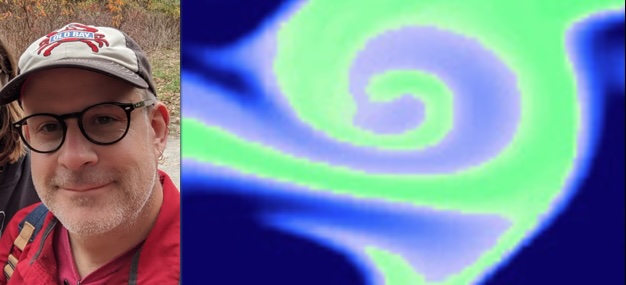 |
| About | People | Alumni/ae | Publications | Projects | Movies | Teaching | Contact | DEEP Sciences |
This figure shows an estimate of monthly climatology of how rapidly mixed layer eddies tend to restratify the ocean surface mixed layer derived from satellite and ship data. The units indicate how much surface cooling would be needed to balance this eddy restratificaton (Fox-Kemper & Ferrari, 2008). Alongside, the new SEANOE mixed layer depth climatology is shown (de Boyer-Montegut, 2022) using a nice projection mapping code from Barry Klinger.
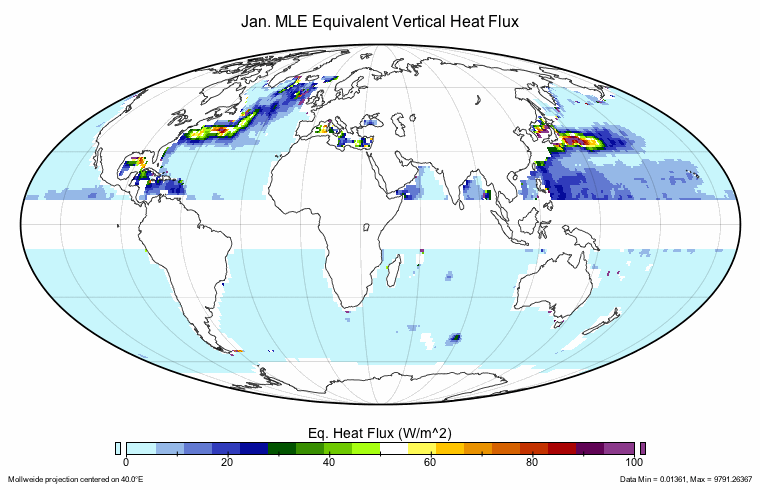
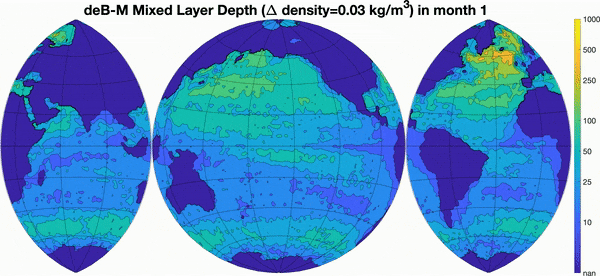 |
|

|
Baylor's Youtube ChannelBaylor's Youtube. |
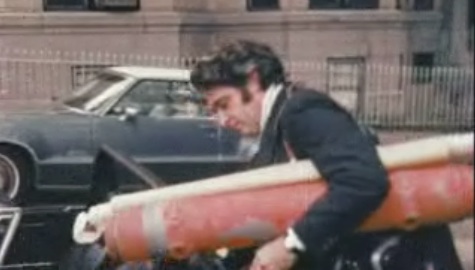
|
Where it all began: (Mid-Ocean Dynamics Experiment) MODE-I (1970-1976)Youtube. Featuring some young oceanographers: Stommel, Robinson (left), Swallow, Wunsch, Rhines, Bretherton, Schmitz, Munk, Richardson, Sanford, Rossby, McWilliams, ... |

|
Classic Fluid Mechanics Films by the National Committee for Fluid Mechanics FilmsPerhaps the nicest visualizations of fluid flow. Also, some nice geophysical fluid dynamics experiments here by Hart and Kittelman and here by Marshall's lab. |
Movies using the MIT General Circulation ModelA hundred days of 2km resolution of an idealized ocean surface boundary layer (with submesoscale fronts and eddies) mesoscale eddy interaction problem. This problem is forced with cooling and heating at the surface to generate the surface boundary layer, and temperature restoring at the sides to generate an eddy field. Note the smaller scale instabilities within the surface boundary layer. A movie zooming in on one such instability is here. This movie shows how the mixed-layer instabilities are involved in a Rossby adjustment problem of an initially-resting density front, with parameters appropriate for the ocean mixed layer. This movie shows the same adjustment occurring on top of stable density stratification. This movie and this movie show the effects of adding a diurnal cycle of heating and cooling at the ocean surface (they differ in parameterization of the small-scale turbulence). This movie shows plan views. MLEs and Hurricanes: Mixed layer eddies are also involved in restratification after a Hurricane wake passes. This movie shows a recovery after a typical degree of Hurricane mixing. The eddies compete with wind and solar and latent heating to return to normal stratification. This movie compares the simulation with Mixed Layer Eddies (3d run, upper panels) with an identically-forced run that is only 2-dimensional. The eddies require a 3d flow to grow, so this is a quick way to see their effects. The bottom panel shows the difference between the two runs, and it reveals that the near surface is quickly restored by heating and wind, while the deepest part of the trough is mixed away by eddies. This movie shows what happens without heating and wind, both with and without mixed layer eddies (3d and 2d). |
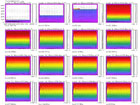
|
Movies using the Hallberg Isopycnal ModelSide views of a calculation of an idealized Ocean with steady winds and restoring to a surface density profile (similar to Cox & Bryan '84). First, a 2 degree spin-up (0-500 yrs). After 500 years at 2 degrees, a 1 degree model was run for 100 yrs (500-600 yrs). Then a relatively viscous, 100-year 0.5 degree run ensued (600-700 yrs). Afterwards, 50 years at 0.5 degrees and a lower viscosity were calculated (700-750). Years 750-775 were calculated at 0.2 degrees with strong eddies. Quicktime. Only the 0.2 degree segment 750-775 years: Quicktime. Monthly-means resolved mass transport (i.e., no diffusive fluxes plotted) superimposed on potential vorticity (shown only where the pot. density layer is more than ~1 m thick) for the Cox & Bryan-like model. Watch the time in the upper left closely, the snapshot interval changes during major transitions. Quicktime. Only the 0.2 degree segment 750-775 years: Quicktime. Monthly-means of resolved mass transport (i.e., no diffusive fluxes plotted) superimposed on monthly-means of potential thickness (1/pot. vorticity) for the Cox & Bryan-like model. Quicktime. Only the 0.2 degree segment 750-775 years: Quicktime. Snapshots of resolved mass transport (i.e., no diffusive fluxes plotted) superimposed on snapshots of layer thickness for the Cox & Bryan-like model. Quicktime. Only the 0.2 degree segment 750-775 years: Quicktime. Focusing on the formation of mode water by fluxes out of the mixed layer near the separation of the western boundary current: Quicktime. Formation of MODE water when resolution is sufficient to resolve eddies: Quicktime. |
Movies using my barotropic turbulence codeThese two models have the same viscosity in the basin interior, but the right-hand one has increased viscosity in a thin layer near the boundary. This layer is able to control the circulation strength, sith the help of eddy fluxes delivering vorticity from the interior. (a plot of potential vorticity)! Movie. Good parameterization! These two calculations have different viscosities, but very similar time-mean flows. I call these solutions homoparic, for same mean. Movie. These calculations have the same viscosity, but the larger basins have an opposing wind forcing in the northern region. Their circulation strength is reduced by the addition of this region. Movie. The double-gyre on the left is started from rest, while the one on the right is started with an initial condition which breaks the initial symmetry between the southern gyre and the northern gyre. Note how the symmetric, resting initial condition run at first resembles the single-gyre in the middle, and then after the symmetry is broken (by numerical errors) it begins to resemble the solution with symmetry-breaking initial conditions. Thus, the symmetric state is unstable, and the sinuous modes which break the symmetry are very important in the control of the circulation strength. Movie. The situtation is quite different with slip boundary conditions. Here, the middle two-gyre solution has a subtropical boundary current which dominates and overshoots ito the subpolar region. Only the right-hand solution, a slip, double-gyre solution, has an important inter-gyre eddy flux of vorticity. Movie. |
|